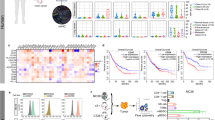Abstract
For cancer gene therapy, replicative adenovirus is a promising vector to overcome low infectivity and poor gene delivery of nonreplicative adenovirus in vivo, but its therapeutic efficacy is still unsatisfactory because of the limited spread of replicative virus in a solid tumor. Therefore, the combined therapy with other antitumor agents may be necessary. Nonreplicative adenovirus expressing a therapeutic gene may be a promising candidate because E1 proteins expressed by replicative adenovirus would render nonreplicative adenovirus replicative, augmenting a transgene expression. In this study, we first found that mouse hepatoma Hepa 1-6 cells were permissive for the replication and cytopathic effect of human adenovirus, which enabled us to examine the potential of combined replicative adenovirus and nonreplicative adenovirus expressing an immunostimulator in an immunocompetent mouse-syngeneic Hepa 1-6 tumor model. Nonreplicative adenovirus expressing interleukin-12 (AdIL-12) was used as a model. In vitro coinfection of two adenoviruses produced higher concentrations of IL-12 than infection of AdIL-12 alone in this cell line. In vivo experiments with Hepa 1-6 tumors in syngeneic immunocompetent C57BL/6 mice showed higher concentrations of serum IL-12 and greater therapeutic efficacy in the combination therapy than infection of either adenovirus. These data indicate that the combination of replicative adenovirus and nonreplicative adenovirus expressing an immunostimulator appears to be very efficacious for cancer gene therapy.
This is a preview of subscription content, access via your institution
Access options
Subscribe to this journal
Receive 12 print issues and online access
$259.00 per year
only $21.58 per issue
Buy this article
- Purchase on Springer Link
- Instant access to full article PDF
Prices may be subject to local taxes which are calculated during checkout




Similar content being viewed by others
References
Kirn D . Clinical research results with dl1520 (Onyx-015), a replicatione-selective adenovirus for the treatment of cancer: what have we learned? Gene Therapy 2001; 8: 89–98.
Heise C, Kirn DH . Replication-selective adenoviruses as oncolytic agents. J Clin Invest 2000; 105: 847–851.
Bischoff JR et al. An adenovirus mutant that replicates selectively in p53-deficient human tumor cells. Science 1996; 274: 373–376.
Alemany R, Balague C, Curiel DT . Replicative adenoviruses for cancer therapy. Nat Biotech 2000; 18: 723–727.
Biederer C et al. Replication-selective viruses for cancer therapy. J Mol Med 2002; 80: 163–175.
Nagayama Y et al. Targeting the replication of adenovirus to p53-defective thyroid carcinoma with a p53-regulated Cre-loxP system. Cancer Gene Ther 2001; 8: 36–44.
Liu Y et al. Enhancement of immunogenicity of tumor cells by cotransfection with genes encoding antisense insulin-like growth factor-1 and B7.1 molecules. Cancer Gene Ther 2000; 7: 456–465.
Melero I et al. IL-12 gene therapy for cancer: in synergy with other immunotherapies. Trends Immunol 2001; 22: 113–115.
Ma XM et al. Immunomodulatory functions and molecular recognition of IL-12. Chem Immunol 1997; 68: 1–22.
Ganly I, Mautner V, Balmain A . Productive replication of human adenoviruses in mouse epithelial cells. J Virol 2000; 74: 2895–2899.
Khoobyarian N et al. Inhibition of melanoma growth in hamsters by type-2 adenovirus. J Surg Oncol 1975; 7: 421–425.
Motoi F et al. Effective gene therapy for pancreatic cancer by cytokines mediated by restricted replication-competent adenovirus. Hum Gene Ther 2000; 11: 223–235.
Agha-Mohammadi S, Lotze MT . Immunomodulation of cancer: potential use of selectively replicating agents. J Clin Invest 2000; 105: 1173–1176.
Toda M et al. In situ cancer vaccination: an IL-12 defective vector/replication-competent herpes simplex virus combination induces local and systemic antitumor activity. J Immunol 1998; 160: 4457–4464.
Parker JN et al. Engineering herpes simplex virus expressing IL-12 in the treatment of experimental murine brain tumors. Proc Natl Acad Sci USA 2000; 97: 2208–2213.
Bennett JJ et al. Interleukin 12 secretion enhances antitumor efficacy of oncolytic herpes simplex viral therapy for colorectal cancer. Ann Surg 2001; 233: 819–826.
Mizuguchi H et al. A simplified system for constructing recombinant adenoviral vectors containing heterologous peptides in the HI loop of their fiber knob. Gene Ther 2001; 8: 730–735.
Nagayama Y et al. Prevention of autoantibody-mediated Graves' hyperthyroidism in mice with interleukin-4, aTh2 cytokine. J Immunol, in press.
Obana S et al. Induction of anti-tumor immunity by mouse tumor cells transfected with mouse interleukin-12 gene. Jpn J Med Sci Biol 1995; 48: 221–236.
Sambrook J, Fritsch EF, Maniatis T . Molecular Cloning: a Laboratory Manual, 2nd edn. Cold Spring Harbor Laboratory: Cold Spring Harbor, 1989.
Author information
Authors and Affiliations
Rights and permissions
About this article
Cite this article
Nagayama, Y., Nakao, K., Mizuguchi, H. et al. Enhanced antitumor effect of combined replicative adenovirus and nonreplicative adenovirus expressing interleukin-12 in an immunocompetent mouse model. Gene Ther 10, 1400–1403 (2003). https://doi.org/10.1038/sj.gt.3302001
Received:
Accepted:
Published:
Issue Date:
DOI: https://doi.org/10.1038/sj.gt.3302001
Keywords
This article is cited by
-
Oncolytic adenovirus programmed by synthetic gene circuit for cancer immunotherapy
Nature Communications (2019)
-
E1A, E1B double-restricted replicative adenovirus at low dose greatly augments tumor-specific suicide gene therapy for gallbladder cancer
Cancer Gene Therapy (2009)



